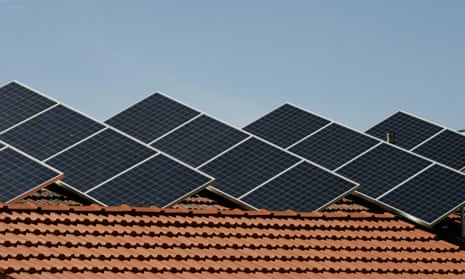Western Australia would not be able to privatise its electricity assets “even if they gave it to them for nothing” because the popularity of rooftop solar panels has made state-owned power stations unprofitable, a renewable energy expert has said.
Prof Philip Jennings, an emeritus professor in energy and physics at Murdoch University, said the uptake of solar was a looming problem for the Barnett government, which has indicated it may consider privatising some or all of its energy assets after the 2017 state election.
An analysis of energy regulator data by Curtin University has found that rooftop solar panels had the capacity to produce more electricity than any power station servicing the Perth grid.
Jennings said WA’s electricity network was 66% over capacity, thanks in part to an unexpected increase in rooftop solar.
“Effectively we have built another very large power station on the rooftops of Perth, and that is what has thrown the government’s calculations out because they didn’t factor it into their calculations when they decided to go in and bring [coal-fired power stations] Muja A and B back online,” Jennings told Guardian Australia.
The Muja A and B power stations at Collie, 200km south of Perth, described as the “oldest and least-efficient” power stations in WA, were decommissioned in 2007 but recommissioned after more than $250m in upgrades and a brief period of mothballing in 2014.
They are used intermittently at high-demand times.
The power stations, which Jennings described as “not particularly clean and not particularly efficient”, were tipped to be among the state assets up for sale in a bid by the treasurer, Mike Nahan, to curb WA’s credit rating.
But Jennings said unless the state’s energy profile changed, investors were unlikely to be interested in Muja or any other assets.
“I think they would be very keen to get the power stations or the network off their books as soon as they possibly can, but they need to make some income from it,” he said. “At the present situation I don’t think anyone would take it even if they gave it to them for nothing.”
Jennings said the government may be forced to increase the fixed rate paid by electricity customers, or require the fixed rate be paid even by homes that are not on the grid, to counteract the effect of household solar and keep its network profitable.
The cost of electricity in WA has increased 85% since 2008, and the number of houses with solar panels has increased by 40%.
“Every time they put up the tariff for coal-fired power in WA it just encourages people to put solar on their rooftops,” he said. “We’re not talking solar panels in Cottesloe [the beachfront inner-city suburb where the state premier, Colin Barnett, lives]. The general take-up rates are not in the wealthy suburbs, they are in the mortgage belt. People factor it into the cost of building a house.”
Prof Peter Newman, who co-wrote the analysis of rooftop solar with research fellow Jemma Green for Curtin University, said the number of solar panels in Perth was expected to grow by 25% a year, which he said would only make the state’s fossil-fuel-powered power stations less attractive to private industry.
“I reckon the sooner they do it the better,” he said.
However Green said the poles-and-wires network itself “would have considerable value” on the private market because its operating costs were protected against the impact of rooftop solar.
“That’s why the generators are complaining about lower demand – they are selling less power, and Western Power at the same time are taking a greater percentage of the capped tariff,” Green said.
“So the generators are the ones suffering financially – particularly Synergy, who have overestimated demand and entered into long term take-or-pay contracts for electricity they don’t have buyers for.”
Nahan, who is also the energy minister, has previously said any plan to privatise the electricity network would have to be taken to an election.
Asked if he would take it to the 2017 election, Nahan said this week: “Although there are no immediate plans to do so, this state government is not opposed to selling individual power assets and it could be a possibility in the future.”
He also said that any decision to close individual power plants would be considered “in due course” and that he “continued to support” the use of rooftop solar.
This article was amended on 7 January 2016 to add the name of study co-author Jemma Green and correct Philip Jennings’s university to Murdoch.

Comments (…)
Sign in or create your Guardian account to join the discussion